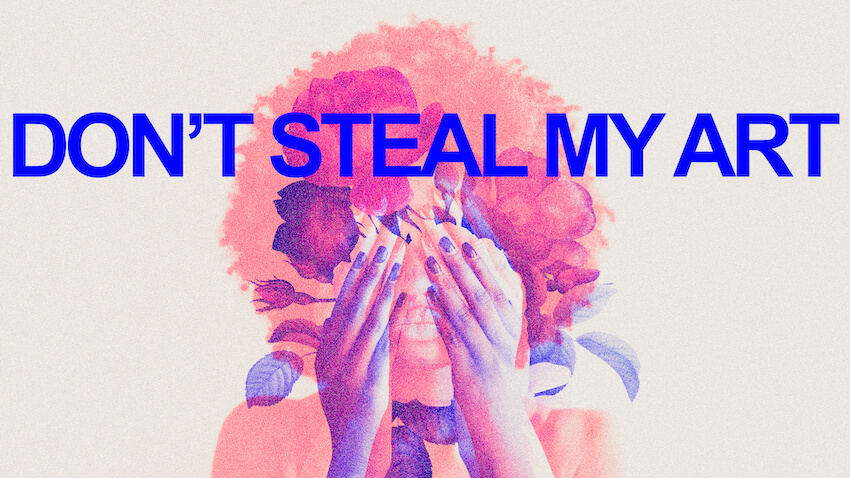
Table of Contents
A bad watermark ruins your art
Have you ever had a piece of art and felt the need to add a watermark?
Many artists believe that using a watermark makes them look professional. But you should be aware that a poorly designed and disruptive watermark is a sign that an artist is just starting out and won’t encourage anyone to hire you. Also, it ruins your artwork, especially if it’s hard to read and doesn’t make any sense.
Here are some tips to follow to get the perfect watermark for your art that is easy to read, represents your brand, and is placed in a way that doesn’t detract from your artwork.
How to add a watermark?
This article is not about “should you or shouldn’t you add watermarks to your artwork”. After all, the artwork is yours and you are the best person to decide whether to watermark it based on how it looks and where you upload it. As the owner, this is your personal preference and entirely up to you! This article discusses what a good watermark is and what features you should consider when designing or ordering a watermark so that your artwork is not ruined.
So you will be able to watermark your art without ruining it and preserve its artistic value 😉
First of all, there are many different ways to add a watermark to your art. Depending on what type of art you are creating, you can use different tools and techniques to add it. If you are creating a digital image, you can use a drawing program (like Photoshop or Gimp) and add a watermark to the image. If your artwork is printed, you can use a stamp or seal to add a watermark to it. Many print shops also offer services to add a watermark on the printed work.
If you don’t know how to design and add a watermark yourself, you can hire someone to do it for you. You can easily hire a photo editor and after listing the details you want, just wait for them to deliver the job and rest assured that they will do the job in the best possible way.
We’ll mostly cover digital art in this article, but a bad watermark ruins both digital art and printed art, so you should be careful about both scenarios.
How to recognize a good watermark?
The good thing is that you can spot bad watermarked artwork from miles away! They mainly include overly large, intrusive watermarks that cover a large part of the image, watermarks that are added with low resolution and watermarks that use a very small font that is not easy to read and is annoying. So a bad watermark is not only distracting, it can make a beautiful image look downright awful.
Here are 6 main characteristics of a good watermark:
1. Legible
Make sure that your watermark is clear and easy to read so that people can understand what it says. If you are writing something in letters, use a pretty text font that is also easy to read, For example, if you use any kind of calligraphy font, they may be impossible to read. A font with a distinct style can help protect against copying and replication. keep in mind that If your watermark is not legible, it only diminishes your work.
2. Unique
The point of the signature is to ensure the authenticity of the artwork and identifies you as the creator. Choose a watermark that is specific to you or your brand, so that it is easily recognizable and distinguishable from others. Additionally, unique watermarks give copyright holders the ability to determine content ownership and to track the chain of transmission from the original owner of the content to the end user. Having a unique watermark also helps to prove authorship in case of any disputes.
3. Non-intrusive
Your watermark should not detract from the content of the image or video. Choose the appropriate and unobtrusive font, size, and opacity. As for size, it is recommended that your watermark take up no more than 1/16 of your photo. It is also best to reduce the opacity as much as possible. Large, colored watermarks, detract from the image as they can compete with the subject.
4. Placed in a strategic location
Choose a location for your watermark that is less likely to be cropped or obscured when the image is shared or reposted. it better Be placed in a discreet area of the image that does not interfere with the view of the image but will make it more difficult to remove or clone out. for example, If your watermark is toward the edge of the photo, it is even easier to remove it.
5. Hard to remove
Make it difficult for people to remove or obscure your watermark. You can use a semi-transparent watermark or place it in a location that would be difficult to crop out or clone over. But to be honest, It would be great if something as simple as a watermark could protect you from piracy. but unfortunately, this isn’t the case. Watermarks that are visible are easily removed or covered by other watermarks.
6. Consistency
Imagine having to find all your old artwork and re-watermark them to match your current logo! It is almost impossible. However, if you don’t replace your previously watermarked works with your updated watermarks, your brand will be diluted and confused. Therefore, you better use the same watermark consistently across all of your images and videos, so that it is easily recognizable and associated with your brand.
Below are 3 photos that are badly watermarked. As mentioned earlier, you can spot a bad watermark without being a Photoshop expert. Based on the above, can you tell which things were not considered in these watermarks that ruined these artworks?

Conclusion
Having consistently high-quality work is what makes you appear professional. If you do have a watermark, consider hiring a designer to help you create it. You can also consult with several designers and ask for their opinion.
Don’t forget that the purpose of a watermark is more to show ownership and style, you don’t want it to ruin your image. before starting to add a watermark, it’s good to evaluate it with all of the items above, if it fits, then add it and you’ll have a perfect watermark that won’t ruin your artwork.

Last but not least, if you are really worried about your art being stolen or used without your permission, the only way to ensure it is never to post or upload your images anywhere on the internet. After all, your art is your soul and you should take good care of it 🙂










